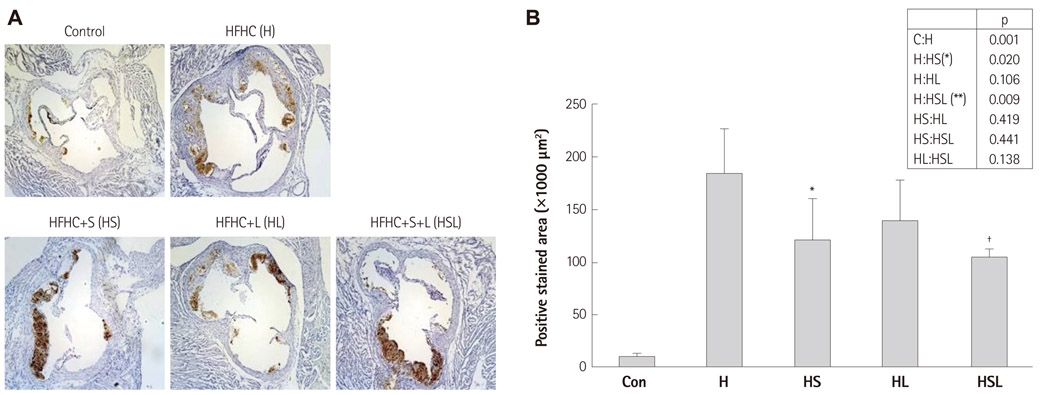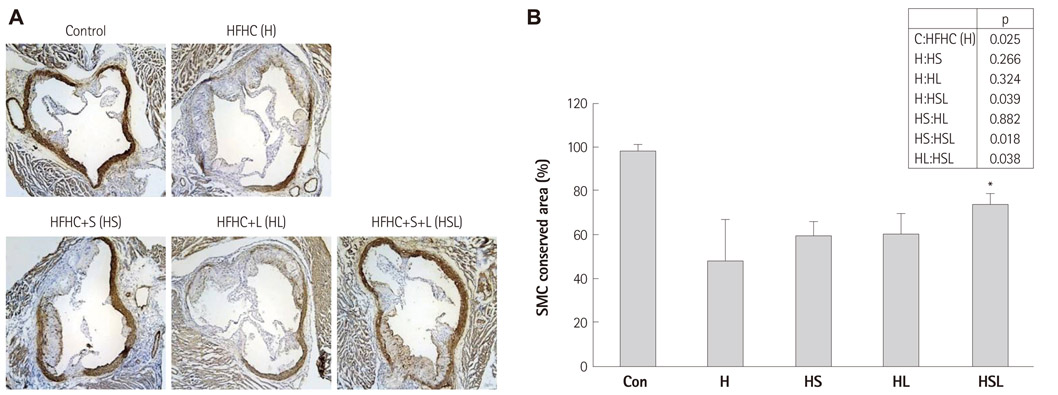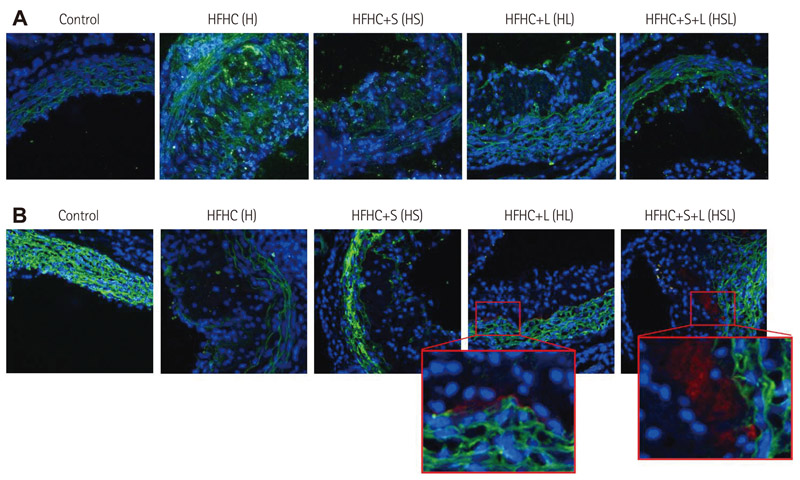Korean Circ J.
2012 Aug;42(8):543-550. 10.4070/kcj.2012.42.8.543.
Simvastatin and Losartan Differentially and Synergistically Inhibit Atherosclerosis in Apolipoprotein E-/- Mice
- Affiliations
-
- 1Samsung Biomedical Research Institute, Samsung Medical Center, Sungkyunkwan University School of Medicine, Seoul, Korea.
- 2Department of Cardiology, Samsung Medical Center, Sungkyunkwan University School of Medicine, Seoul, Korea. jepark39@gmail.com
- KMID: 2225004
- DOI: http://doi.org/10.4070/kcj.2012.42.8.543
Abstract
- BACKGROUND AND OBJECTIVES
Since statins and angiotensin receptor blockers are a frequently prescribed combination in patients with atherosclerotic cardiovascular diseases, we tested the interactive effects of simvastatin and losartan on atherosclerosis in apolipoprotein E (apoE)-/- mice.
MATERIALS AND METHODS
Apolipoprotein E-/- mice were fed a high-fat, high-cholesterol (HFHC) diet for 12 weeks, with and without simvastatin (40 mg/kg) and/or losartan (20 mg/kg). The mice were divided into 5 groups and were fed as follows: regular chow (control diet, n=5), HFHC diet (n=6), HFHC diet with losartan (n=6), HFHC diet with simvastatin (n=6), and HFHC diet with both losartan and simvastatin (n=6).
RESULTS
Losartan treatment in apoE-/- mice significantly decreased atherosclerotic lesion areas in whole aortic strips stained with Oil Red O. The plaque area measured at the aortic sinus level was reduced significantly by 17% (HFHC; 346830.9+/-52915.8 microm2 vs. HFHC plus losartan; 255965.3+/-74057.7 microm2, p<0.05) in the losartan-treated group. Simvastatin and simvastatin plus losartan treatments reduced macrophage infiltration into lesions by 33% (HFHC; 183575.6+/-43211.2 microm2 vs. HFHC plus simvastatin; 120556.0+/-39282.8 microm2, p<0.05) and 44% (HFHC; 183575.6+/-43211.2 microm2 vs. HFHC plus simvastatin and losartan; 103229.0+/-8473.3 microm2, p<0.001, respectively). In mice fed the HFHC diet alone, the smooth muscle cell layer in the aortic media was almost undetectable. In mice co-treated with losartan and simvastatin, the smooth muscle layer was more than 60% preserved (p<0.05). Given alone, losartan showed a slightly stronger effect than simvastatin; however, treatment with losartan plus simvastatin induced a greater inhibitory effect on atherosclerosis than either drug given alone. Serum lipid profiles did not differ significantly among the groups.
CONCLUSION
Losartan displayed anti-atherosclerotic effects in apoE-/- mice that were equivalent to or greater than the effects of simvastatin. Combined treatment with these drugs had greater effect than either drug alone.
Keyword
MeSH Terms
-
Angiotensin Receptor Antagonists
Animals
Apolipoproteins
Atherosclerosis
Azo Compounds
Cardiovascular Diseases
Diet
Humans
Losartan
Macrophages
Mice
Mice, Knockout
Models, Animal
Muscle, Smooth
Myocytes, Smooth Muscle
Simvastatin
Sinus of Valsalva
Angiotensin Receptor Antagonists
Apolipoproteins
Azo Compounds
Losartan
Simvastatin
Figure
Reference
-
1. Corti R, Fayad ZA, Fuster V, et al. Effects of lipid-lowering by simvastatin on human atherosclerotic lesions: a longitudinal study by high-resolution, noninvasive magnetic resonance imaging. Circulation. 2001. 104:249–252.2. Oliver MF, de Feyter PJ, Lubsen J, et al. Effect of simvastatin on coronary atheroma: the Multicentre Anti-Atheroma Study (MAAS). Lancet. 1994. 344:633–638.3. Corti R, Fuster V, Fayad ZA, et al. Lipid lowering by simvastatin induces regression of human atherosclerotic lesions: two years' follow-up by high-resolution noninvasive magnetic resonance imaging. Circulation. 2002. 106:2884–2887.4. Schartl M, Bocksch W, Koschyk DH, et al. Use of intravascular ultrasound to compare effects of different strategies of lipid-lowering therapy on plaque volume and composition in patients with coronary artery disease. Circulation. 2001. 104:387–392.5. Albert MA, Danielson E, Rifai N, Ridker PM. PRINCE Investigators. Effect of statin therapy on C-reactive protein levels: the pravastatin inflammation/CRP evaluation (PRINCE): a randomized trial and cohort study. JAMA. 2001. 286:64–70.6. Hernández-Perera O, Pérez-Sala D, Navarro-Antolín J, et al. Effects of the 3-hydroxy-3-methylglutaryl-CoA reductase inhibitors, atorvastatin and simvastatin, on the expression of endothelin-1 and endothelial nitric oxide synthase in vascular endothelial cells. J Clin Invest. 1998. 101:2711–2719.7. Guzik TJ, Hoch NE, Brown KA, et al. Role of the T cell in the genesis of angiotensin II induced hypertension and vascular dysfunction. J Exp Med. 2007. 204:2449–2460.8. ALLHAT Officers and Coordinators for the ALLHAT Collaborative Reserarch Group. The Antihypertensive and Lipid-Lowering Treatment to Prevent Heart Attack Trial. Major outcomes in high-risk hypertensive patients randomized to angiotensin-converting enzyme inhibitor or calcium channel blocker vs diuretic: the Antihypertensive and Lipid-Lowering Treatment to Prevent Heart Attack Trial (ALLHAT). JAMA. 2002. 288:2981–2997.9. Yusuf S, Sleight P, Pogue J, Bosch J, Davies R, Dagenais G. Effects of an angiotensin-converting-enzyme inhibitor, ramipril, on cardiovascular events in high-risk patients: the Heart Outcomes Prevention Evaluation Study Investigators. N Engl J Med. 2000. 342:145–153.10. Weber MA, Julius S, Kjeldsen SE, et al. Blood pressure dependent and independent effects of antihypertensive treatment on clinical events in the VALUE Trial. Lancet. 2004. 363:2049–2051.11. Dahlöf B, Devereux RB, Kjeldsen SE, et al. Cardiovascular morbidity and mortality in the Losartan Intervention For Endpoint reduction in hypertension study (LIFE): a randomised trial against atenolol. Lancet. 2002. 359:995–1003.12. Griendling KK, Minieri CA, Ollerenshaw JD, Alexander RW. Angiotensin II stimulates NADH and NADPH oxidase activity in cultured vascular smooth muscle cells. Circ Res. 1994. 74:1141–1148.13. Koh KK, Quon MJ, Han SH, et al. Additive beneficial effects of losartan combined with simvastatin in the treatment of hypercholesterolemic, hypertensive patients. Circulation. 2004. 110:3687–3692.14. Han SH, Koh KK, Quon MJ, Lee Y, Shin EK. The effects of simvastatin, losartan, and combined therapy on soluble CD40 ligand in hypercholesterolemic, hypertensive patients. Atherosclerosis. 2007. 190:205–211.15. Bayorh MA, Layas MF, Mann G, Feuerstein GZ, Eatman D. The effect of diet on simvastatin and losartan enhancement of endothelial function. Clin Exp Hypertens. 2007. 29:311–325.16. Sever PS, Dahlöf B, Poulter NR, et al. Prevention of coronary and stroke events with atorvastatin in hypertensive patients who have average or lower-than-average cholesterol concentrations, in the Anglo-Scandinavian Cardiac Outcomes Trial--Lipid Lowering Arm (ASCOT-LLA): a multicentre randomised controlled trial. Lancet. 2003. 361:1149–1158.17. Koh KK. Effects of statins on vascular wall: vasomotor function, inflammation, and plaque stability. Cardiovasc Res. 2000. 47:648–657.18. Robinson JG, Smith B, Maheshwari N, Schrott H. Pleiotropic effects of statins: benefit beyond cholesterol reduction? a meta-regression analysis. J Am Coll Cardiol. 2005. 46:1855–1862.19. Liao JK, Laufs U. Pleiotropic effects of statins. Annu Rev Pharmacol Toxicol. 2005. 45:89–118.20. Sparrow CP, Burton CA, Hernandez M, et al. Simvastatin has anti-inflammatory and antiatherosclerotic activities independent of plasma cholesterol lowering. Arterioscler Thromb Vasc Biol. 2001. 21:115–121.21. Hayek T, Attias J, Coleman R, et al. The angiotensin-converting enzyme inhibitor, fosinopril, and the angiotensin II receptor antagonist, losartan, inhibit LDL oxidation and attenuate atherosclerosis independent of lowering blood pressure in apolipoprotein E deficient mice. Cardiovasc Res. 1999. 44:579–587.22. Kim SH, Lee ES, Lee JY, et al. Multiplex coherent anti-stokes Raman spectroscopy images intact atheromatous lesions and concomitantly identifies distinct chemical profiles of atherosclerotic lipids. Circ Res. 2010. 106:1332–1341.23. Rezaie-Majd A, Maca T, Bucek RA, et al. Simvastatin reduces expression of cytokines interleukin-6, interleukin-8, and monocyte chemoattractant protein-1 in circulating monocytes from hypercholesterolemic patients. Arterioscler Thromb Vasc Biol. 2002. 22:1194–1199.24. Papakonstantinou E, Roth M, Kokkas B, Papadopoulos C, Karakiulakis G. Losartan inhibits the angiotensin II-induced modifications on fibrinolysis and matrix deposition by primary human vascular smooth muscle cells. J Cardiovasc Pharmacol. 2001. 38:715–728.25. Chen H, Li D, Mehta JL. Modulation of matrix metalloproteinase-1, its tissue inhibitor, and nuclear factor-kappa B by losartan in hypercholesterolemic rabbits. J Cardiovasc Pharmacol. 2002. 39:332–339.26. Park HK, Park EC, Bae SW, et al. Expression of heat shock protein 27 in human atherosclerotic plaques and increased plasma level of heat shock protein 27 in patients with acute coronary syndrome. Circulation. 2006. 114:886–893.27. Martin-Ventura JL, Duran MC, Blanco-Colio LM, et al. Identification by a differential proteomic approach of heat shock protein 27 as a potential marker of atherosclerosis. Circulation. 2004. 110:2216–2219.
- Full Text Links
- Actions
-
Cited
- CITED
-
- Close
- Share
- Similar articles
-
- Effect of Conventional Dose of Simvastatin on Plaque Regression and Vascular Remodeling in the Peristent Reference Segments of Normocholesterolemic Patients: A Serial Intravascular Ultrasound Assessment
- Effect of ezetimibe and simvastatin combination in Korean hypercholesterolemic patients
- Clinical Effects of Simvastatin in Patients with Hypercholesterolemia
- Effect of Human Bcl-2 Gene Expression on the Peripheral Atherosclerotic Lesions of Apolipoprotein E-Deficient Mouse
- The safety and efficacy of ezetimibe and simvastatin combination therapy in Korean patients with primary hypercholesterolemia






